Overview
The title "9 Essential Sales KPIs Every Small Business Owner Should Track" raises an important question: which key performance indicators (KPIs) are vital for small business owners to monitor in their sales processes? In this article, we delve into nine crucial KPIs, including:
- Sales revenue
- Customer acquisition cost
- Conversion rate
- Net promoter score
By tracking these metrics, you can optimize your sales strategies, strengthen client relationships, and ultimately drive your business growth.
We understand the challenges you face as a small business owner, and recognizing these KPIs can empower you to make informed decisions. Imagine how much more effective your sales process could be when you have clear insights into your performance. Each KPI serves as a valuable tool that helps you navigate your unique business landscape.
As you reflect on your current sales practices, consider how these indicators can illuminate areas for improvement. Together, we can achieve success by focusing on what truly matters. By embracing these metrics, you not only enhance your business operations but also foster a deeper connection with your clients. Let's embark on this journey of growth and transformation, ensuring your business thrives in today's competitive environment.
Introduction
In today's rapidly evolving business landscape, we understand that small business owners face unique challenges. Many are turning to innovative solutions to streamline their sales processes and enhance overall performance. Wayy.ai is here to support you in this transformation, harnessing advanced AI technology to automate your sales outreach and track key metrics that can drive your success.
As the demand for efficient sales strategies grows, it becomes essential to grasp critical metrics such as:
- Sales revenue
- Customer acquisition cost
- Conversion rates
These insights are vital for achieving sustainable growth. In this article, we will explore the various metrics that small businesses should monitor, offering you valuable insights into optimizing your sales strategies, nurturing customer relationships, and ultimately boosting your profitability in an increasingly competitive market.
Together, we can navigate this journey towards success.
Wayy.ai: Automate Sales Outreach and Track Key Metrics
Wayy.ai is a transformative platform designed to automate the outreach process for small business owners like you. By harnessing advanced AI technology, it allows you to concentrate on what truly matters—your core business activities—while effectively managing client acquisition. With comprehensive tracking of key performance metrics, such as sales KPI, you can easily oversee your outreach effectiveness and adjust strategies as needed. Imagine receiving daily email updates that provide insights on leads contacted, interest expressed, and enhancements in conversion rates. Wayy.ai empowers small teams to achieve remarkable results, even without .
The impact of AI on outreach efforts is significant. Research indicates that automation can greatly enhance response rates. For instance, integrating voicemails into outreach efforts has shown to increase response rates by 15%, demonstrating the power of strategic communication techniques. Furthermore, as the global door-to-door market is projected to grow at an annual rate of 6.4% until 2030, the demand for efficient selling solutions like Wayy.ai becomes increasingly relevant. In fact, in 2024, an astonishing 70% of B2B representatives fell short of their sales KPI, underscoring the critical need for effective selling strategies. Wayy.ai addresses this gap by equipping entrepreneurs with the necessary tools to automate their outreach efforts. This ensures that you can engage prospects at the right moment and improve conversion rates. By focusing on the unique challenges faced by small enterprises, Wayy.ai remains at the forefront of AI-powered selling platforms in 2025. It offers an economical solution that not only streamlines the client acquisition process but also enhances overall revenue performance. Together, we can navigate these challenges and achieve success in your business journey.
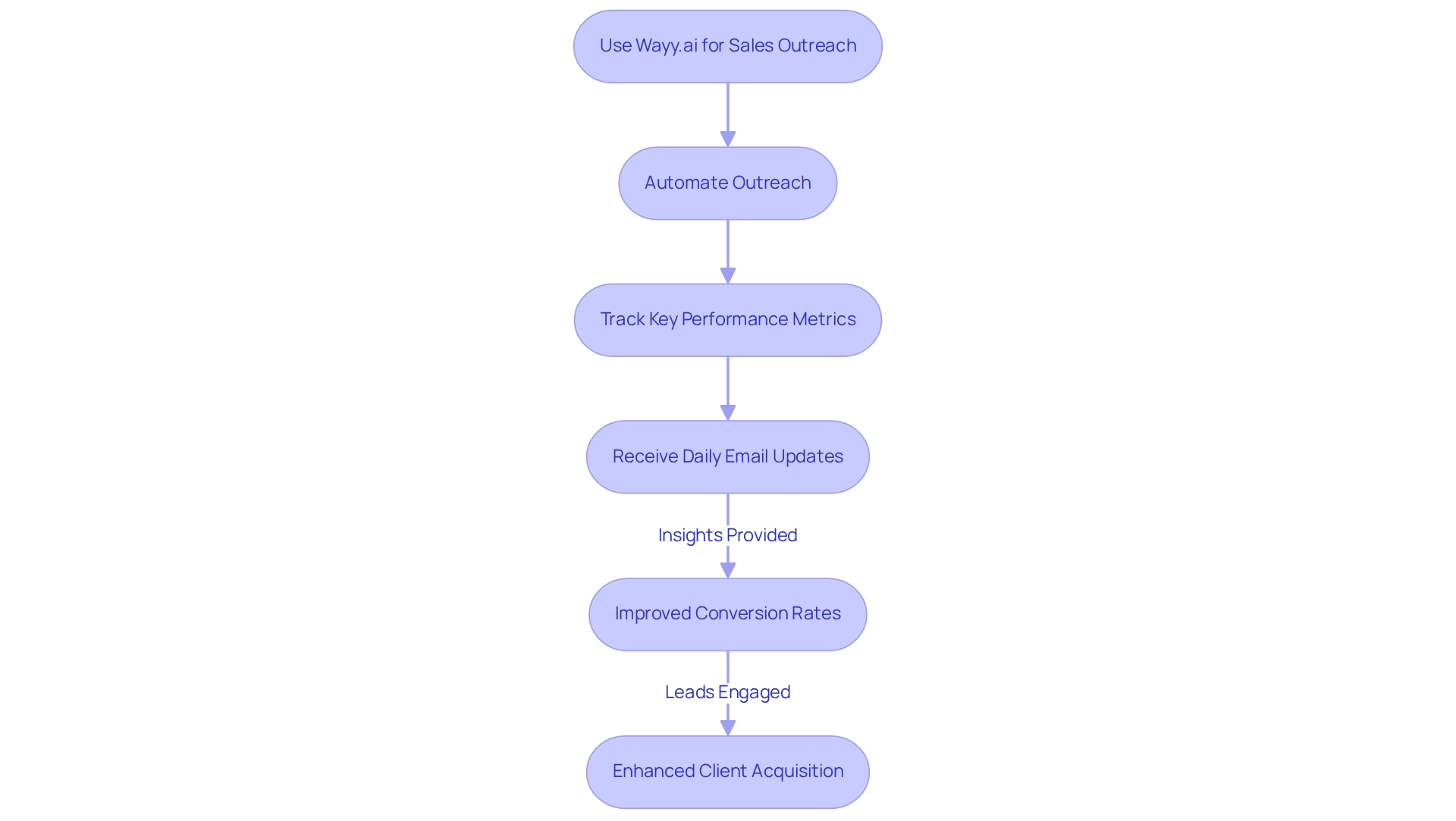
Sales Revenue: Measure Overall Business Performance
Sales revenue represents the total income generated from the exchange of goods or services, serving as a vital indicator of a company's performance. For , keeping an eye on revenue is essential for assessing financial health and uncovering growth opportunities. By analyzing revenue data and focusing on sales KPI, you can identify trends, forecast future sales, and make informed decisions about resource allocation and strategic planning.
In 2025, the importance of revenue becomes even more pronounced as small businesses increasingly recognize the need to adapt to market demands. For instance, the average annual income for women-owned businesses saw a remarkable increase of 13.1% from 2023 to 2024, highlighting a narrowing revenue gap with their male counterparts. This trend not only signifies progress toward financial equality but also showcases the potential for growth through effective marketing strategies. It encourages local entrepreneurs to refine their approaches to attract and retain customers.
To effectively track revenue trends, small business owners should consider implementing real-time trend analysis in order to meet their sales KPI. This proactive strategy helps identify clients at risk of leaving, allowing you to take steps to enhance retention, which is crucial for achieving your sales KPI. Such an approach not only deepens your understanding of market dynamics but also guides adjustments to your product offerings and marketing strategies. Remember, success hinges on creating a model that resonates with your target audience while leveraging data-driven insights to boost your sales KPI.
Experts emphasize that having the right offer and attracting the right clients are crucial for small business success. As Anita Anthonj, CEO of Talaera, wisely noted, "If you’re interested to learn more about the experiences of women in the corporate world, check out the following interview with Anita Anthonj." This perspective underscores the importance of aligning your marketing strategies with market needs.
By consistently reviewing your income and analyzing sales KPI, small businesses can improve efficiency and adapt to changing market conditions. This ongoing evaluation is key to sustaining growth and ensuring your business meets its sales KPI while remaining competitive in a dynamic environment. As ownership of small businesses continues to diversify, with Generation X and Baby Boomers accounting for 47% and 37% respectively, the ability to monitor sales KPI and assess revenue trends will be increasingly vital for long-term success. Furthermore, understanding the current average income for small businesses in 2025 will provide valuable insights as you navigate your growth plans.
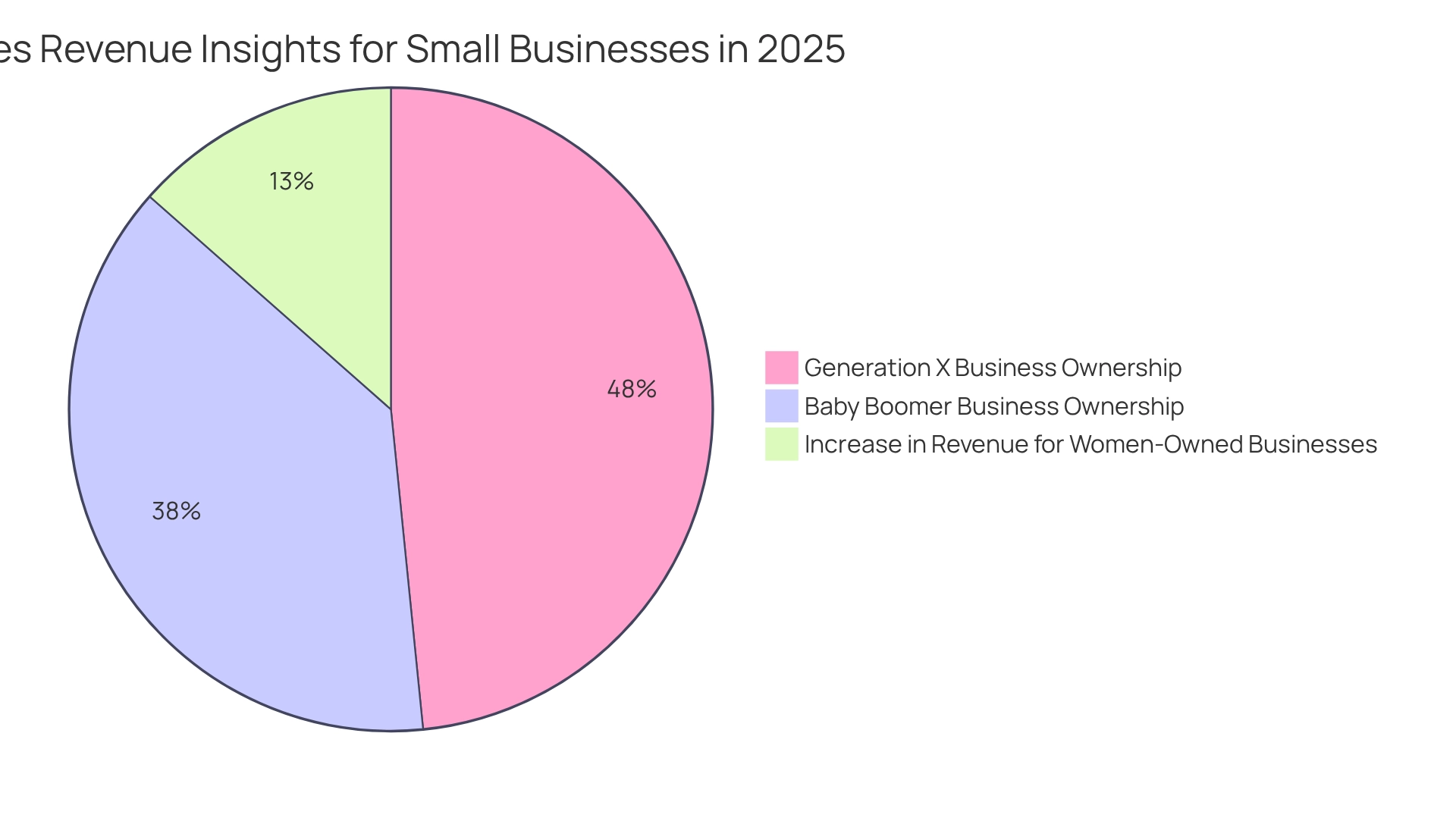
Customer Acquisition Cost: Evaluate Marketing Efficiency
Client Acquisition Cost (CAC) is not just a number; it's a vital metric that small businesses must pay attention to. By dividing total marketing and sales expenses by the number of new clients acquired within a specific timeframe, you can gauge how effectively your marketing strategies are working. A high CAC may indicate that there are inefficiencies in your marketing efforts, which might require a strategic reassessment to optimize your returns. Remember, effective marketing strategies that lower CAC can significantly enhance your profitability. Ideally, should represent only a third of your clients' lifetime value (LTV). As Sehar Fatima wisely notes, "A good CAC should represent a third of your client LTV."
Looking ahead to 2025, the average CAC for small enterprises is projected to reflect ongoing trends in digital marketing and customer engagement. This emphasizes the importance of adapting your strategies to stay competitive. By closely monitoring your CAC, you can ensure that your marketing investments contribute to sustainable growth, ultimately leading to enhanced revenue performance.
Consider leveraging platforms like Wayy.ai, which streamline client acquisition through features such as a one-click sales playbook and targeted outreach. This enables you to establish over 60 target client connections each month! Such automation not only reduces CAC but also enhances your overall marketing efficiency. Regular evaluation of CAC is made easier by Wayy.ai's tools, which help track marketing effectiveness and inform future investment decisions. This ensures that your resources are allocated to the most impactful strategies, allowing you to focus on what truly matters—growing your business together.
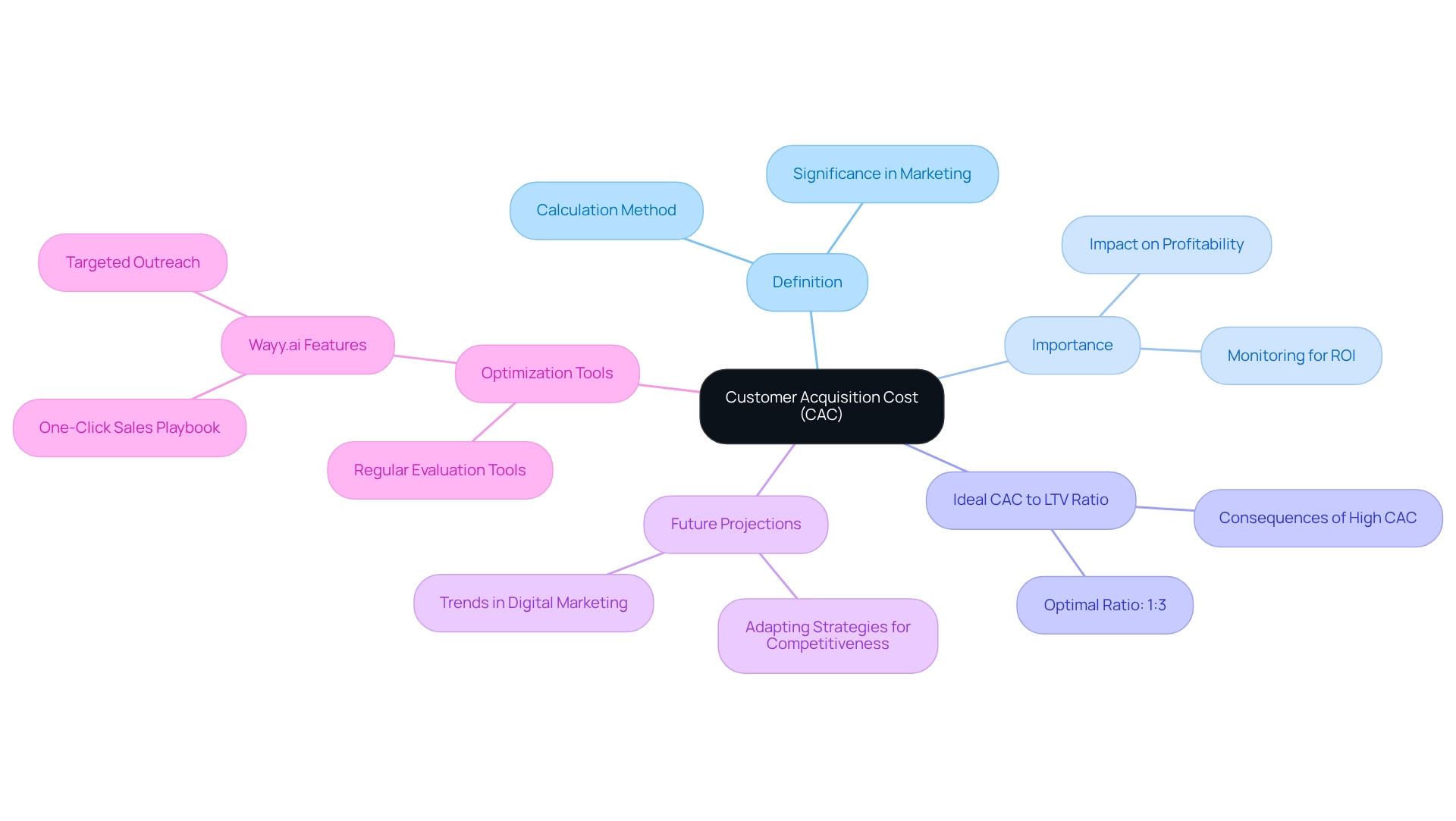
Customer Lifetime Value: Assess Long-Term Profitability
(CLV) is a vital metric that quantifies the total revenue an organization can anticipate from an individual throughout their relationship. For small business owners, understanding and calculating CLV is essential for assessing the long-term profitability of their clientele. This metric not only helps identify high-value clients but also informs targeted marketing strategies designed to enhance retention.
Have you ever wondered how some businesses seem to thrive while others struggle? Studies show that companies effectively monitoring CLV can make informed decisions regarding resource allocation and client relationship management. This leads to improved client retention and higher repeat transactions. For instance, merchants who have successfully combined online and in-store sales through platforms like Shopify have reported an impressive 30% revenue growth year-over-year. This highlights the significant financial advantages of prioritizing client relationships. As Tobias Lütke, CEO and co-founder of Shopify, wisely stated, 'Win by helping others win is the best strategy,' underscoring the importance of fostering connections with clients.
A higher CLV indicates that investing in client satisfaction and loyalty can yield substantial returns. As small enterprises navigate changing market conditions and evolving customer preferences, consistently evaluating CLV becomes crucial. This practice not only refines marketing efforts but also enhances overall corporate strategy by incorporating sales KPIs, ensuring sustainable growth.
To calculate CLV in 2025, small business owners can use the formula:
CLV = (Average Purchase Value) x (Average Purchase Frequency) x (Customer Lifespan).
Understanding the typical CLV for small enterprises in 2025 can provide important benchmarks for performance assessment. It enables businesses to measure their effectiveness in retaining clients and maximizing revenue. By prioritizing sales KPI in their client retention strategies, small enterprises can cultivate meaningful connections that drive profitability and long-term success. Moreover, monitoring CLV allows companies to make informed decisions regarding resource allocation and customer relationship management, resulting in improved customer retention and greater repeat purchases.
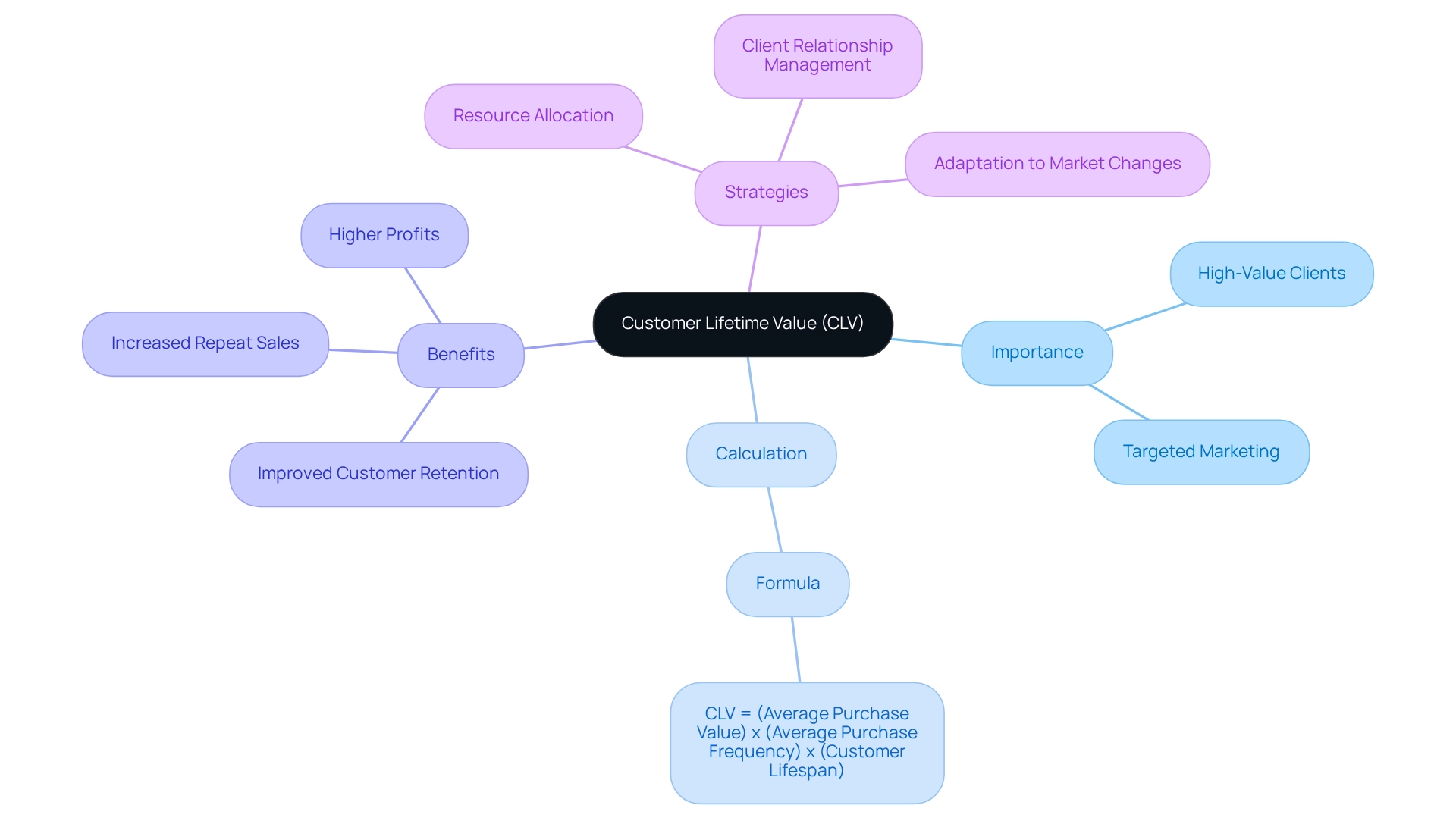
Conversion Rate: Optimize Sales Strategies
Understanding your conversion rate is vital for your small business. This key metric is calculated by dividing the number of conversions, or transactions, by the total number of leads generated. A higher conversion rate not only reflects successful interactions with your prospects but also indicates a strong closing process. As we move into 2025, grasping and improving these rates becomes increasingly important, especially as many small enterprises face challenges in achieving their revenue goals.
By frequently analyzing your conversion rates, you can pinpoint effective strategies and refine your outreach efforts, ultimately maximizing your sales potential. Have you considered how targeted outreach strategies might significantly boost your conversion rates? Businesses that implement such tactics often see remarkable improvements.
With tools like , you can receive daily email insights that track essential metrics, including the number of leads contacted and those who expressed interest, along with enhancements in your conversion rates. By focusing on improving your conversion rates and utilizing supportive tools, you can elevate your revenue outcomes and ensure sustainable growth in today’s competitive market. Together, we can navigate these challenges and achieve success.
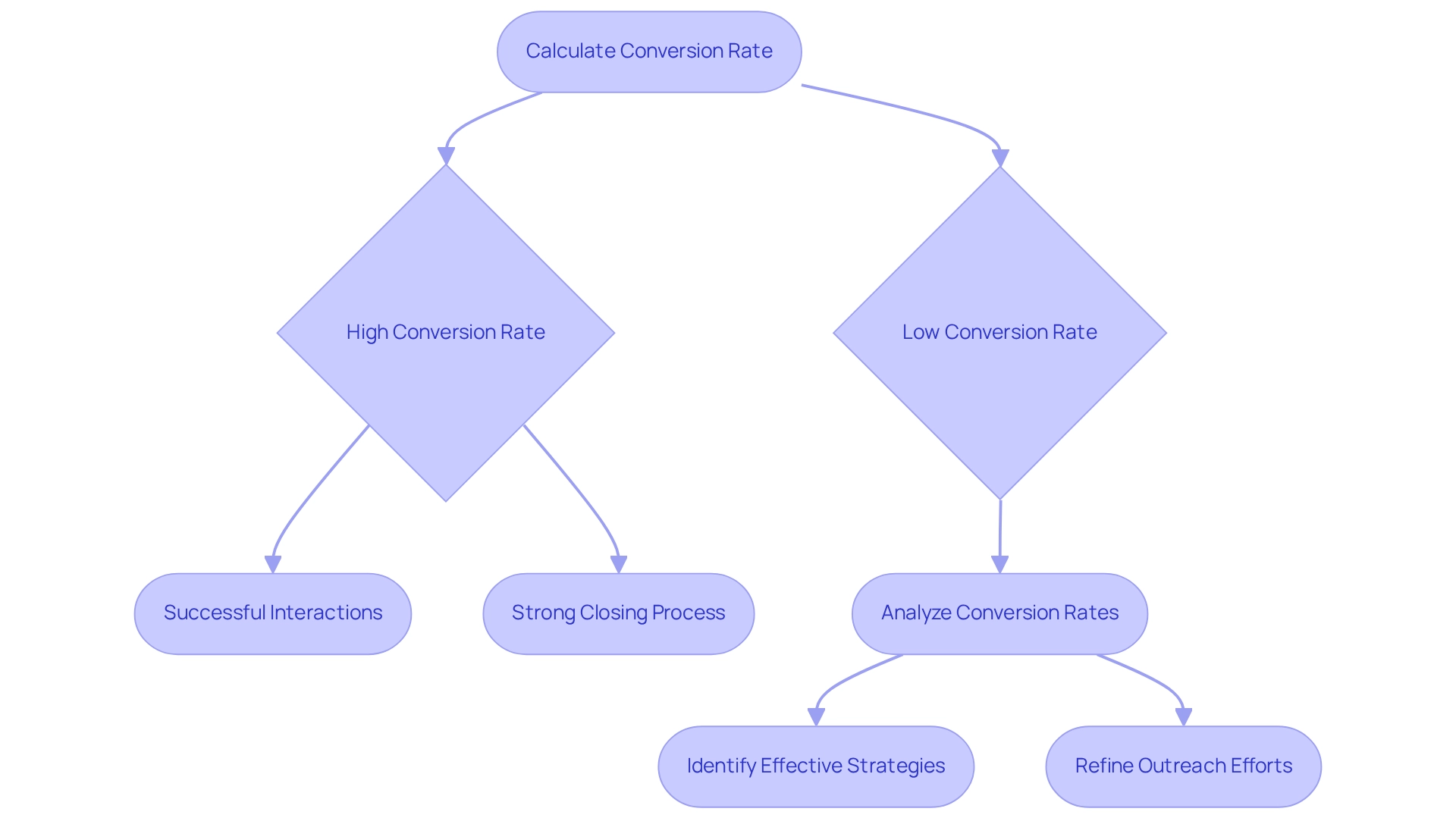
Lead-to-Customer Ratio: Analyze Lead Generation Effectiveness
The lead-to-customer ratio is a vital metric for small enterprises, calculated by dividing the number of leads that convert into customers by the total number of leads generated. This ratio acts as a barometer for assessing the effectiveness of your lead generation efforts. Have you ever wondered if your leads are truly converting? A low lead-to-customer ratio may signal issues such as insufficient lead quality or a need for refinement in the sales process. By closely analyzing this ratio, you can identify areas for enhancement in your lead generation strategies, ultimately improving your conversion rates.
In 2025, the average lead-to-client ratio for small enterprises is anticipated to remain around 2-5%, depending on the sector. Consistent monitoring of this metric is crucial, as it guides your promotional and marketing tactics, enabling you to concentrate on the most effective routes for lead generation and conversion. For instance, companies that have implemented systematic tracking of their lead-to-customer ratios have reported significant improvements in their sales outcomes, refining their approaches based on data-driven insights.
To enhance your lead-to-customer ratio, consider adopting several strategies, such as:
- Improving lead qualification processes
- Utilizing
- Leveraging automation tools like Wayy.ai
These tools not only streamline outreach but also provide valuable analytics that help in understanding customer behavior and preferences. Laura Popa, a Marketing Specialist, emphasizes that "analyzing lead-to-customer ratios provides actionable insights that can drive growth."
Statistics suggest that effective lead generation can greatly influence small enterprises, with those utilizing strong strategies experiencing up to a 50% rise in conversion rates. Expert opinions underscore the importance of analyzing lead-to-customer ratios, as they provide actionable insights that can drive growth. For instance, companies that consistently evaluate their lead generation efficiency are more suitably placed to modify their strategies and attain greater success rates.
Case studies show that small enterprises that actively track and assess their lead-to-customer ratios have effectively enhanced their sales procedures by monitoring their sales KPI. By concentrating on quality rather than quantity in lead generation, these firms have improved their outreach efforts, leading to a more effective sales funnel and greater customer acquisition, ultimately enhancing their sales KPI. Instruments ranging from spreadsheets to sophisticated CRM applications have been employed to monitor this metric, ensuring that you can enhance your marketing and sales initiatives efficiently. Together, we can achieve success in refining your lead generation strategies.
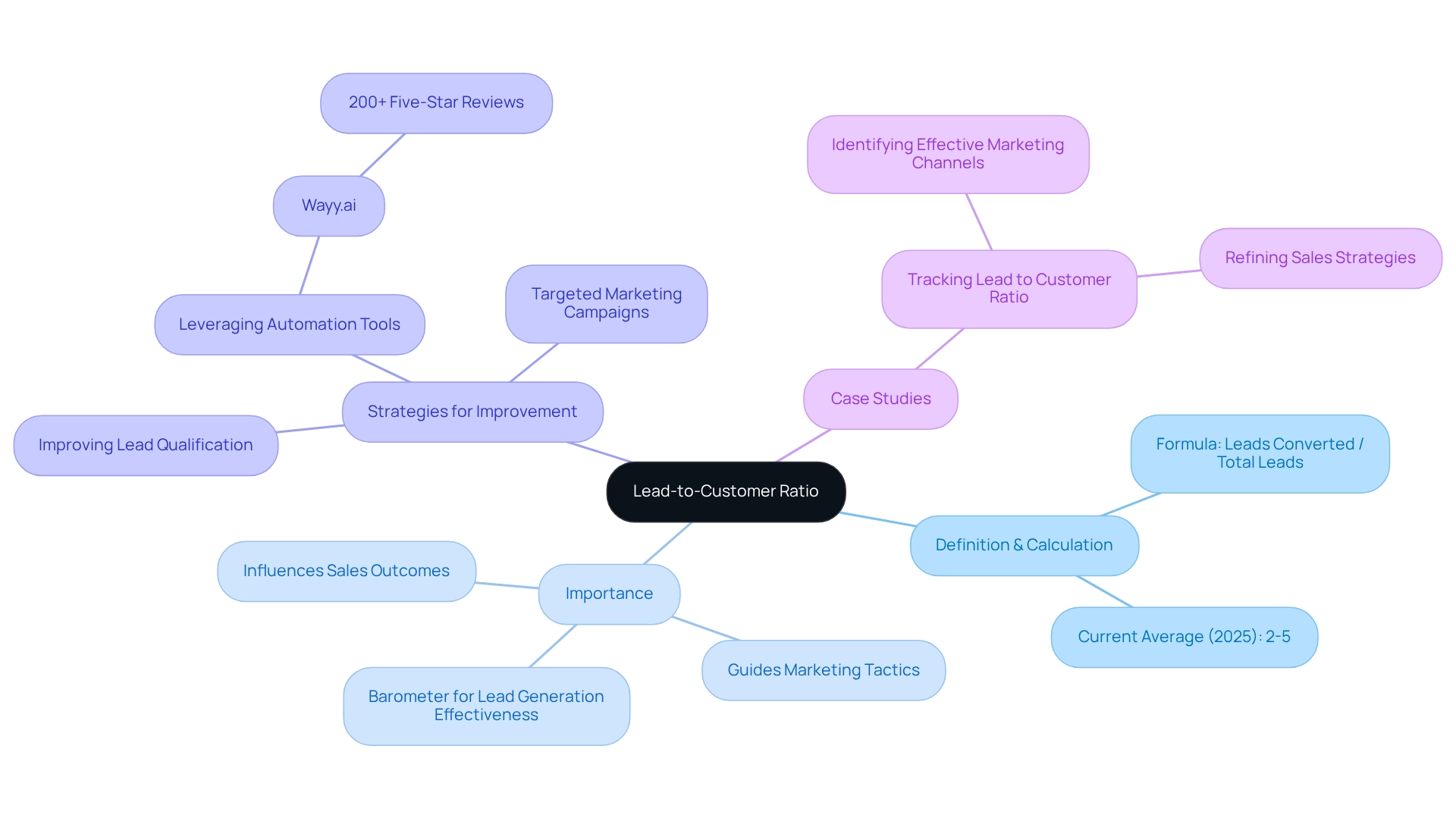
Sales Growth Rate: Track Business Progress Over Time
The revenue growth rate is a vital indicator, measuring the percentage increase in transactions over a specific duration. This measure is essential for monitoring your organization's progress and evaluating the effectiveness of by analyzing sales KPI. By analyzing revenue growth rates over time, you can identify patterns, assess the impact of your promotional efforts, and make informed decisions about future investments. A consistent upward trend in revenue growth signifies a strong trajectory for your business.
As we look ahead to 2025, small businesses are expected to face various revenue growth rate patterns influenced by market dynamics and consumer behavior. Current statistics reveal that many small business owners are working diligently, often putting in over 60 hours a week to improve their revenue performance. This dedication underscores the importance of tracking revenue growth over time, allowing you to pinpoint successful strategies and areas that may need enhancement.
For instance, small businesses that effectively monitor their revenue growth rates can adapt their strategies based on real-time information, leading to more strategic decision-making. Experts emphasize that keeping an eye on these sales KPI metrics is crucial for your growth, as they provide clarity on your performance and help establish realistic growth objectives. Furthermore, case studies show that companies prioritizing sales KPI often achieve steady expansion, illustrating the tangible benefits of diligent monitoring and evaluation. As Ashley Taylor, Product Manager, insightfully noted, "Launching an enterprise has never been simpler, due to the presence of digital tools and access to worldwide markets," highlighting the need for efficient tracking of transactions in this ever-evolving landscape.
Together, let’s embrace these tools and insights to navigate your business journey effectively.
![]()
Average Deal Size: Set Realistic Sales Targets
Understanding your average deal size is crucial for your business's success. This metric, calculated by dividing total revenue by the number of deals closed in a specific period, provides valuable insights into the average income generated per transaction. By grasping this concept, you can set realistic sales goals that feel achievable.
Imagine being able to tailor your strategies to focus on high-value opportunities. By doing so, you can optimize your pricing structures to better meet your customers' needs. Regularly evaluating your average deal size not only enhances your revenue forecasting but also improves how you allocate resources.
We understand the challenges you face as a small business owner, and by taking these steps, you can empower yourself to navigate them more effectively. Together, let’s work towards achieving with confidence.
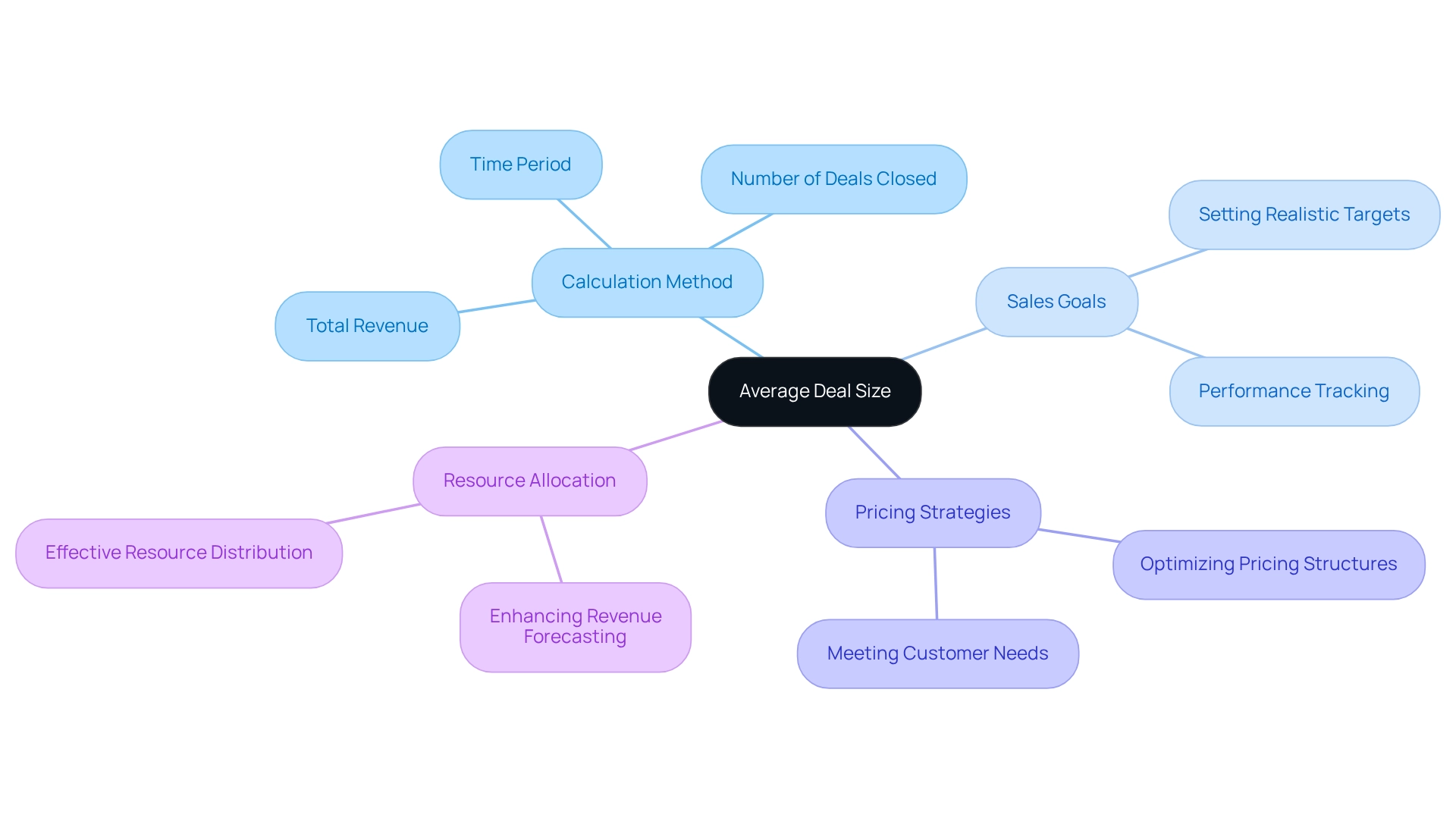
Sales Cycle Length: Identify Process Bottlenecks
The sales cycle length encompasses the total time from the initial contact with a lead to the completion of a transaction. This vital metric, known as , serves as a diagnostic tool for entrepreneurs, helping them identify obstacles within their revenue processes. By carefully examining the cycle's duration, organizations can uncover specific areas where delays occur, allowing them to implement focused strategies to enhance operations.
A shorter transaction cycle often signifies a more efficient selling process, which not only increases the ability to seize more opportunities but also improves overall revenue performance, reflected in the sales KPI. In 2025, the average transaction cycle length for modest enterprises is projected to be around 30 to 45 days. This highlights the importance of effective management.
Organizations that actively assess and enhance their revenue cycle can experience significant improvements in their sales KPI. Consider this: studies indicate that 42% of firms have seen a drop in success rates over the past year. This underscores the necessity of refining sales approaches to enhance the sales KPI.
To accurately evaluate sales cycle duration, small business owners should keep track of essential phases of the selling process, from lead generation to finalization. Implementing AI-driven marketing techniques, such as those offered by Wayy.ai, can further enhance this process. Wayy.ai provides functionalities like a one-click sales guide and targeted outreach, along with daily email insights that track leads, interest, and conversion rates. This enables companies to connect with prospects based on real-time buyer signals.
Understanding ideal outreach periods—like cold calling on Wednesdays or at 11 AM on Thursdays—can significantly boost response rates and conversion effectiveness, ultimately impacting critical sales KPIs. By focusing on these optimization tactics and leveraging insights from sales data provided by Wayy.ai, small enterprises can not only shorten their sales cycle duration but also enhance their overall sales performance. Together, we can ensure that you remain competitive in a challenging market.
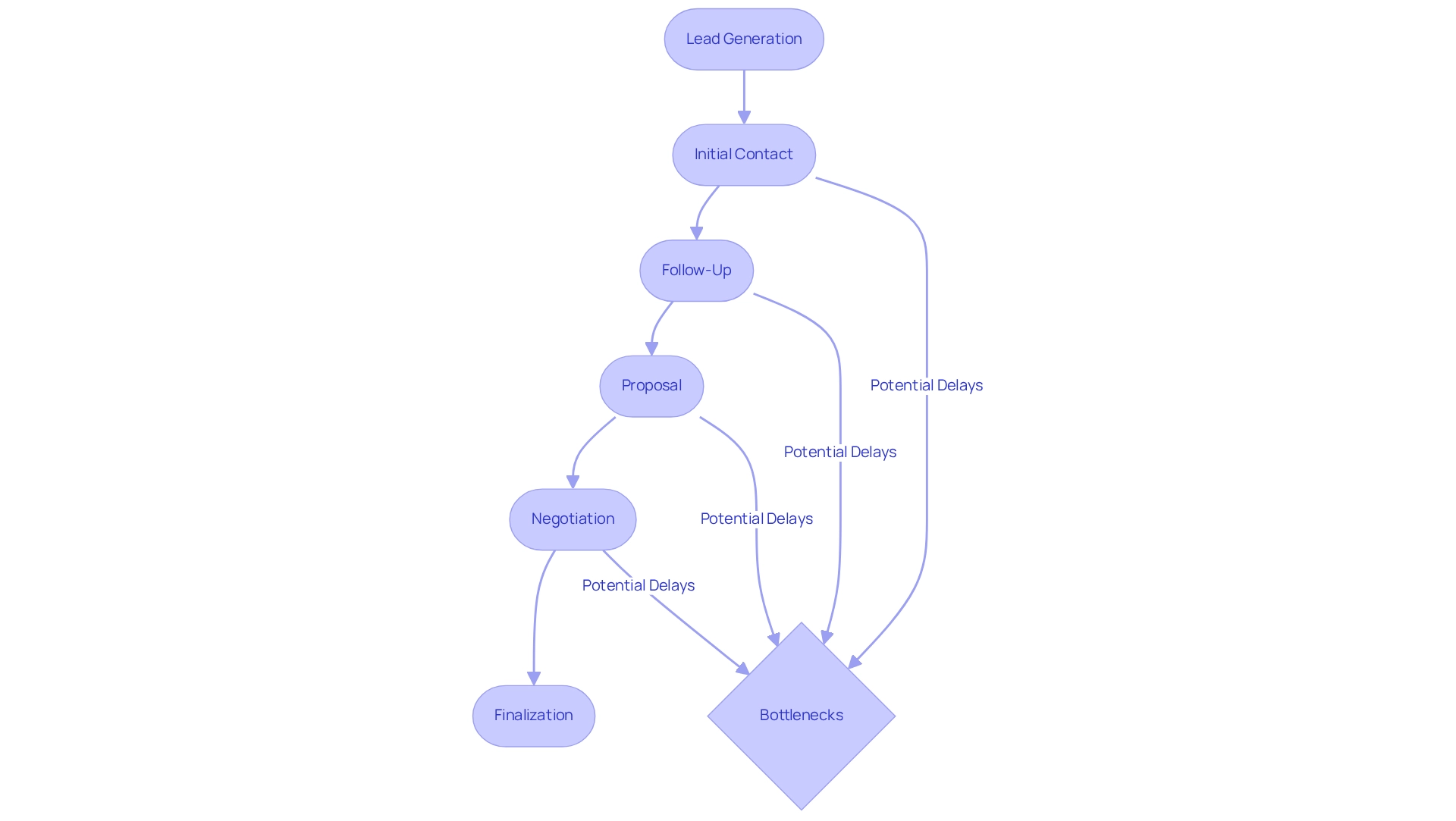
Net Promoter Score: Gauge Customer Satisfaction and Loyalty
The Net Promoter Score (NPS) is an essential metric for understanding client loyalty, asking a simple yet powerful question: how likely are individuals to recommend your business to others? This straightforward survey can provide deep insights into client satisfaction and reveal areas that may need improvement. A high NPS indicates strong loyalty, while a low score could point to underlying issues that deserve your attention.
As a small business owner, embracing NPS can significantly enhance your client engagement strategies and foster lasting loyalty, ultimately driving growth. Did you know that 71% of experience leaders believe personalization is crucial for shaping their strategies? This highlights the importance of tailoring experiences to meet your clients' needs. Furthermore, studies indicate that 48% of clients are willing to spend more when their experiences are customized, emphasizing the value of understanding client sentiments through NPS.
Calculating NPS is simple: subtract the percentage of detractors (those who rate their likelihood to recommend as 0-6) from the percentage of promoters (those who rate it as 9-10). This clear computation provides a snapshot of client loyalty and satisfaction, enabling small businesses to make informed decisions that enhance service offerings and strengthen relationships. By focusing on improving your NPS, you can cultivate a loyal clientele that contributes to your ongoing growth.
Additionally, consider utilizing social media as . Brands that respond quickly on these platforms often build stronger connections with their audience, enhancing customer satisfaction. By integrating technology, including AI, you can effectively measure and improve your NPS, ensuring your business remains competitive in today's ever-evolving market. Together, we can navigate these challenges and achieve success.

Conclusion
In the ever-evolving world of small business, understanding and leveraging key sales metrics is not just important; it's essential for your success. This article has explored vital metrics such as:
- Sales revenue
- Customer acquisition cost
- Customer lifetime value
- Conversion rates
Together, these metrics empower you, the small business owner, to refine your sales strategies effectively. By actively monitoring these indicators, you can uncover growth opportunities, optimize your marketing efforts, and strengthen your customer relationships.
Integrating advanced tools like Wayy.ai can simplify the tracking of these metrics, allowing you to focus on what you do best—running your business. With automation taking care of outreach and providing valuable insights, you can navigate the complexities of the market with greater ease. As the landscape continues to change, adapting and utilizing data-driven strategies will be key to maintaining your competitive edge.
Ultimately, the journey toward sustainable growth hinges on the consistent assessment of these metrics, enabling you to make informed decisions and strategic plans. By prioritizing these insights, you can not only face challenges head-on but also seize opportunities that lead to enhanced profitability in an increasingly competitive environment. Embracing this data-centric approach is vital for achieving long-term success and ensuring that your business thrives amidst the complexities of today’s marketplace. Together, we can navigate this journey toward a brighter future.
Frequently Asked Questions
What is Wayy.ai and how does it benefit small business owners?
Wayy.ai is a platform designed to automate the outreach process for small business owners, allowing them to focus on core business activities while effectively managing client acquisition. It provides comprehensive tracking of key performance metrics, enabling users to oversee outreach effectiveness and adjust strategies as needed.
How does Wayy.ai enhance outreach efforts?
Wayy.ai enhances outreach efforts by utilizing advanced AI technology, which has been shown to improve response rates. For example, integrating voicemails into outreach efforts can increase response rates by 15%. This strategic communication technique helps engage prospects at the right moment and improve conversion rates.
Why is monitoring sales revenue important for small businesses?
Monitoring sales revenue is essential for assessing financial health and identifying growth opportunities. It helps small business owners analyze trends, forecast future sales, and make informed decisions regarding resource allocation and strategic planning.
What trends are affecting small business revenue in 2025?
In 2025, small businesses are recognizing the need to adapt to market demands. Notably, women-owned businesses experienced a significant revenue increase, highlighting growth potential through effective marketing strategies. This trend signifies progress toward financial equality and encourages local entrepreneurs to refine their customer attraction and retention approaches.
What is Client Acquisition Cost (CAC) and why is it important?
Client Acquisition Cost (CAC) is a metric that measures the effectiveness of marketing strategies by dividing total marketing and sales expenses by the number of new clients acquired. Monitoring CAC is important because a high CAC may indicate inefficiencies in marketing efforts, necessitating a strategic reassessment to optimize returns and enhance profitability.
How can Wayy.ai assist with reducing Client Acquisition Cost?
Wayy.ai can help reduce Client Acquisition Cost by streamlining client acquisition through features such as a one-click sales playbook and targeted outreach. This automation enables businesses to establish numerous target client connections each month, ultimately enhancing marketing efficiency and lowering CAC.
What should small business owners focus on to improve their sales KPI?
Small business owners should focus on consistently reviewing their income, analyzing sales KPI, and implementing real-time trend analysis. This proactive approach helps identify clients at risk of leaving and guides adjustments to product offerings and marketing strategies, ensuring sustained growth and competitiveness.




